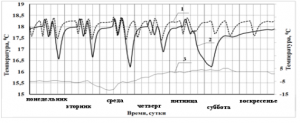OPTIMAL THERMAL CONTROL TO OBTAIN THE MAXIMUM ENERGY SAVINGS IN RESIDENTIAL AND OFFICE BUILDINGS
Problem. Optimal control of building thermal conditions to obtain maximum energy savings for heating (for example, during periods of absence of people) can be done with the help of individual heat point (IHP), and for the of rooms – with the help of programmers / thermostats, in which the manually set point switching on and off heating systems. The problem that it is impossible to predict an individual moment of switching on the heating system every day, because it depends on the current ambient temperature, the power reserve of the heating system, the current thermal state of the building and its thermal inertia.
Proposal solutions. Development and use of adequate models of the thermal regime of buildings and rooms allows for building optimal thermal management to get maximum energy savings in residential and office buildings. Increasing the energy efficiency of buildings is achieved through the development of an optimal algorithm for the building heating system controlling based on measurement of the ambient temperature, the air temperature in several rooms, and simplified adaptive thermal building model that allows you to define an individual moment of switching on the heating system in providing comfort during periods of occupancy in building and the maximum saving heat energy.
The developed algorithm is verified on the administrative building with low energy efficiency (Fig. 1), which allows you to achieve energy savings in heating it to 4-5%, at observance of a normalized air building temperature during working hours (Fig. 2).
Fig. 1. – Building control system thermal regime: left – IHP, center – the object model, right – building
Fig. 2 – The time dependence of the air rooms temperature in optimal control of the building thermal mode
The developed algorithm may be implemented as a program for building heating system computerized management or a improved programming device.
The novelty consists in the improvement of existing algorithm programmer / thermostats, thus achieving large energy savings.
Publications:
- Krukovsky P.G., Tadlia O.Yu., Metel M.A., Sklyarenko D.I. Methodical maintenance of the method of energy saving at the expense of periodic decrease of the air temperature in the room // Industrial heat engineering. – 2014. – Vol. 36, No. 1. – P. 50-58. (RUS)
- Krukovsky P.G., Tadlya O.Yu., Zakovorotny AI, Deineko A.I., Sklyarenko D.I. Some ways to reduce energy consumption of buildings by regulating heat consumption // Industrial Heat Engineering. – 2016. – Vol. 38, No. 1. – P. 62-67. (RUS)
- Pat. 98179 Ukraine, IPC G05B 19/41, G05D 23/00. A method for controlling the temperature of the room during the heating period [Text] / Krukovsky P.G., Tadlia O.Yu., Zakovrotny A.I., Sklyarenko D.I., Deineko A.I. (Ukraine); Applicant and patent holder ITTF of the National Academy of Sciences of Ukraine. – № u201409568; stated. 01.09.14; published 04/24/15, Bul. No. 8/2015. – 4 s. (RUS)


